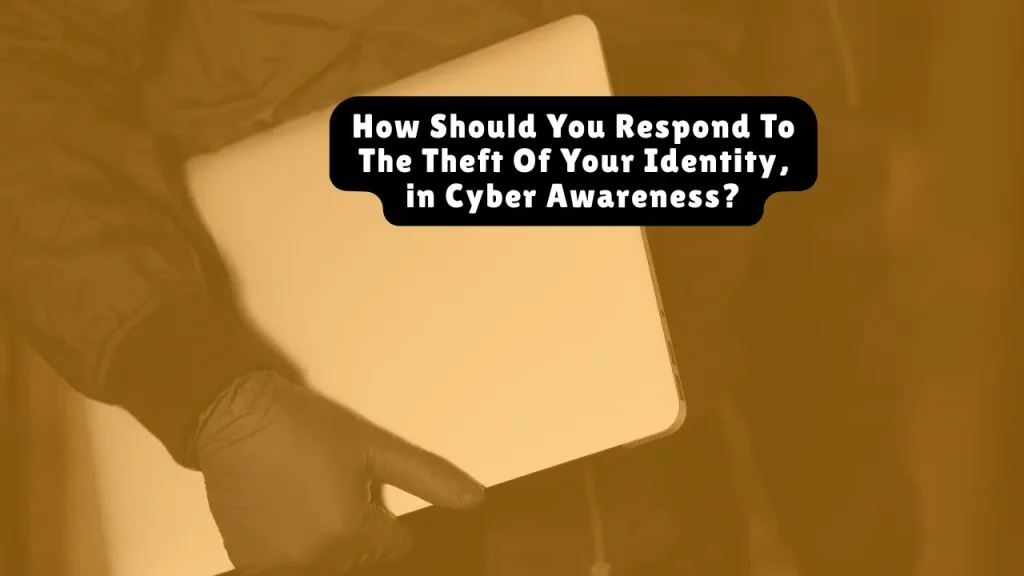How Should You Respond To The Theft Of Your Identity, in Cyber Awareness?
Identity theft recovery starts with freezing your credit, filing an FTC report, alerting banks, and securing online accounts. From legal remedies to emotional support, this guide covers every step to restore your identity and resilience.
If your identity is stolen, act immediately: 1) Freeze your credit, 2) Report to the FTC, 3) File a police report, and 4) Monitor accounts for fraud. Cyber awareness—like enabling MFA and dark web scans—is critical to limiting damage and preventing repeat attacks.
Table of Contents
Why Identity Theft Recovery Matters
With over 422 million individuals affected by data breaches in the U.S. in 2022 alone, identity theft has become disturbingly common. In 2023, a major T-Mobile breach exposed data of 37 million customers. One victim, Maria Rodriguez, spent over a year recovering from credit fraud, IRS scams, and hacked accounts.
Identity theft isn’t just financial—it can be emotionally draining and legally complex. Here’s how to take back control.
Step 1: Freeze Your Credit Immediately
Credit freezes prevent criminals from opening accounts in your name. It’s fast, free, and effective.
Contact the three major credit bureaus:
- Equifax
- Experian
- TransUnion
You’ll get a PIN to unfreeze your credit when needed.
Step 2: File an Identity Theft Report
Go to the FTC’s IdentityTheft.gov to:
- Generate a custom recovery plan
- Create an Identity Theft Report to send to creditors and police
- Access pre-filled dispute letters
Step 3: Report to Local Police
Bring:
- FTC report
- Government-issued ID
- Proof of address
- Any fraudulent account statements
Ask for a copy of the police report—it helps dispute debts and protects your rights.
Related article:
Identity Theft And Mistaken Identity Are The Same?

Step 4: Notify Your Banks and Credit Card Companies
Immediately:
- Close or freeze compromised accounts
- Dispute unauthorized charges
- Ask for new account numbers and cards
- Monitor for further suspicious activity
Use your FTC report and police record as backup if needed.
Read also: How Long Does It Take to Fix Credit After Identity Theft?
Step 5: Secure Your Online Accounts
Upgrade your cybersecurity:
- Change all passwords—use a password manager (e.g., 1Password, Bitwarden)
- Enable multi-factor authentication (MFA)—avoid SMS; use app-based (like Authy) or physical keys (like YubiKey)
- Check if your data is on the dark web via HaveIBeenPwned
Step 6: Replace Compromised Government Documents
Depending on what was stolen:
- Social Security Number (SSN): Contact the SSA
- Driver’s License: Contact your DMV
- Passport: Notify the State Department
- Biometric Data (e.g., fingerprints): While irreversible, alert law enforcement for tracking misuse
Step 7: Consider Legal Action Against Negligent Companies
Companies that fail to protect your data may violate:
- Gramm-Leach-Bliley Act (GLBA)
- FTC Safeguards Rule
You may be eligible for:
- Lawsuits
- Class action settlements
- State attorney general complaints
Example: Victims of the 2023 T-Mobile breach may seek compensation under class-action lawsuits.
Related article: How to File a Police Report for Identity Theft in Texas?
Step 8: Take Care of Your Mental Health
Identity theft is a form of trauma. Victims often feel anxious, isolated, or depressed.
Support options:
- AARP ReST program – Free peer-led support
- Give an Hour – Free mental health services
- Journaling, mindfulness, exercise, and proper sleep
Step 9: Use Tools to Protect Your Identity Long-Term
Monitoring & Insurance
- Dark Web Monitoring: CrowdStrike, Norton, LifeLock
- Credit Monitoring: Alerts from Experian, Equifax, TransUnion
- Identity Theft Insurance: Usually covers legal fees, lost wages, and recovery assistance
Data Privacy Tools
- VPNs: Encrypt your browsing (e.g., NordVPN, ProtonVPN)
- Biometric logins: Fingerprint, face ID
- Limit oversharing: Lock down privacy settings on social media
Step 10: Opt Out of Data Brokers
Data brokers can sell your info. You can request removal:
- OptOutPrescreen
- DMAchoice
- Whitepages
- Spokeo
Step 11: Protect Your Children and Family
Children’s SSNs are prime targets.
Actions to take:
- Request a manual credit check for your child (minors don’t typically have credit)
- Use parental controls and train kids to recognize phishing
- Use family drills—simulate phishing attempts or lost-wallet scenarios
Step 12: Promote Cyber Hygiene at Work
Encourage or request:
- Security training for staff
- Incident response plans
- CISA cybersecurity guidance: cisa.gov
Expert Insights
“Your personal information is out there—it’s how you respond that matters most.”
– Eva Velasquez, President & CEO, Identity Theft Resource Center
“You may think the worst is over after the fraud, but the psychological trauma can last for years.”
– Brett Shannon Johnson, former cybercriminal turned security consultant
FAQs
How long do I have to report identity theft?
Report it as soon as you notice. Federal law (under the FCRA) gives you 60 days to dispute fraudulent charges.
Can I recover stolen money from identity theft?
Possibly—banks and credit cards may reimburse if you report fast. ID theft insurance can also help.
What if my child’s identity is stolen?
File an FTC report, alert the credit bureaus, and request a manual credit file search.
Can I sue a data broker for leaking my data?
Yes, depending on state law. California and Vermont have strict data broker regulations.
Helpful Resources
- FTC Identity Theft Recovery
- IRS Identity Protection PIN
- IC3.gov – FBI Cybercrime Reporting
- Identity Theft Resource Center (ITRC)
- AARP Fraud Watch Network
- NIST Cybersecurity Framework
- VictimConnect.org – Legal and emotional support
Final Thoughts: Identity Theft Recovery Is a Marathon
Identity theft isn’t a one-time problem—it’s an ongoing vulnerability. By combining immediate action, ongoing vigilance, and legal and emotional support, you can regain control and reduce your long-term risk.
You can rebuild not only your credit but your peace of mind.
About the Author

Sarah Klein, JD, is a former consumer rights attorney who spent years helping clients with issues like unfair billing, product disputes, and debt collection practices. At All About Lawyer, she simplifies consumer protection laws so readers can defend their rights and resolve problems with confidence.
Read more about Sarah
